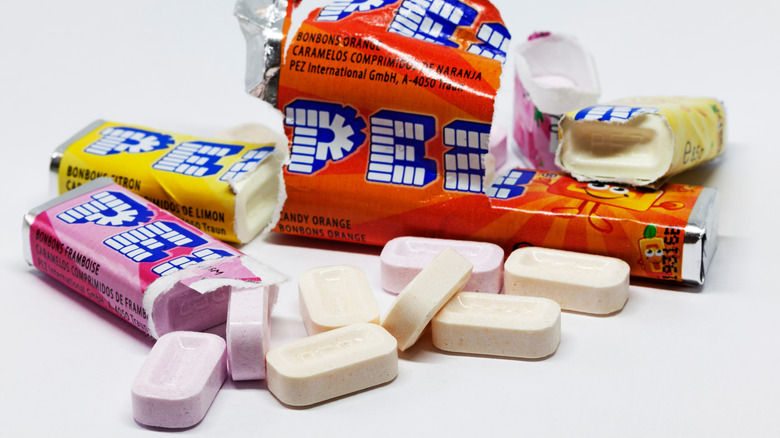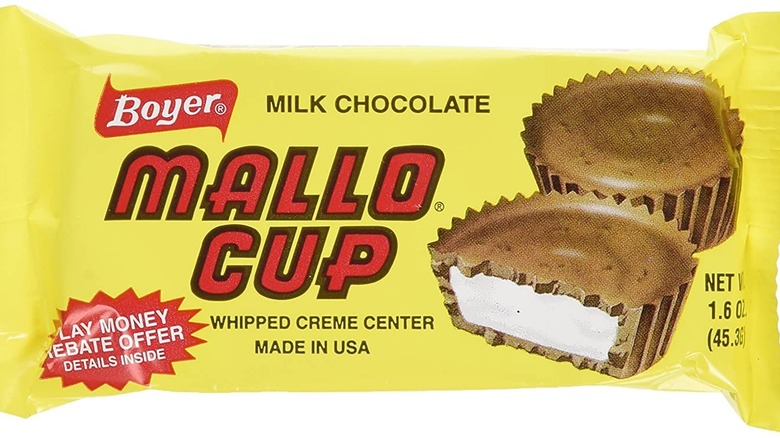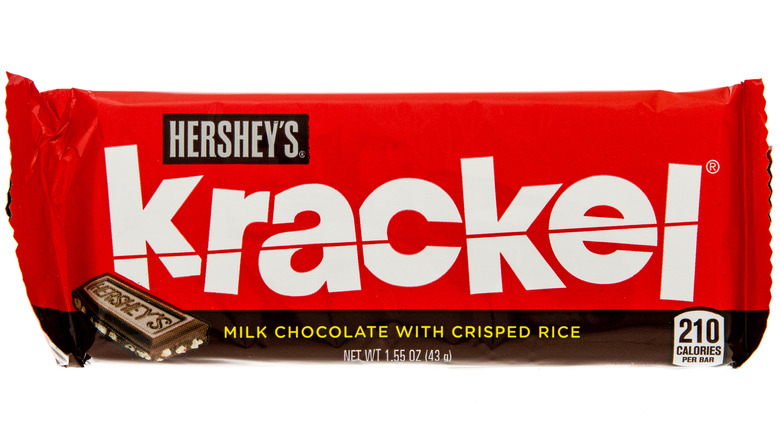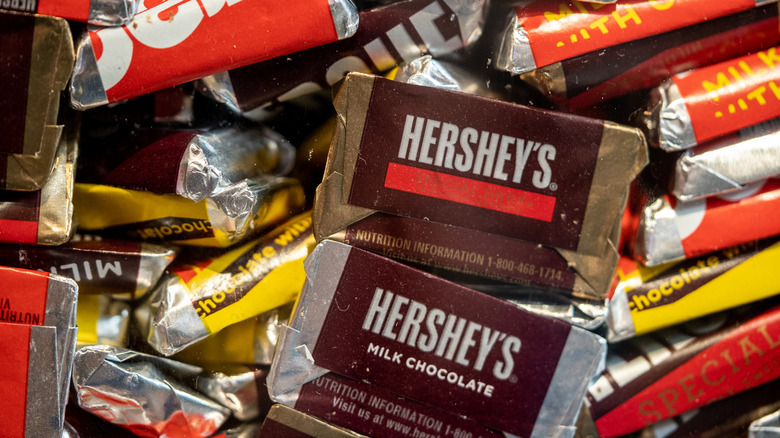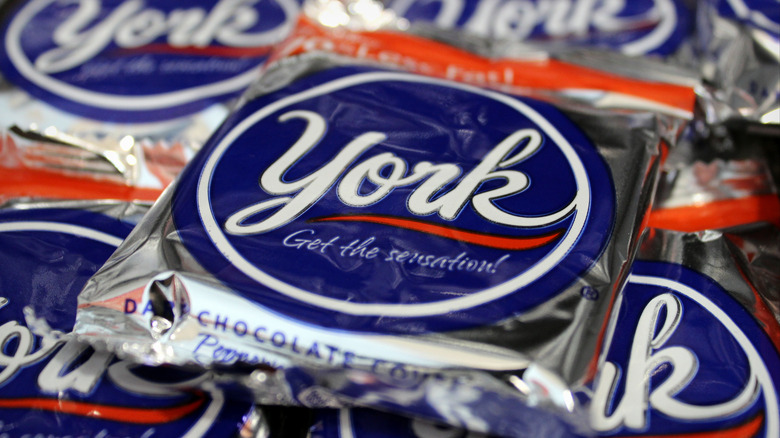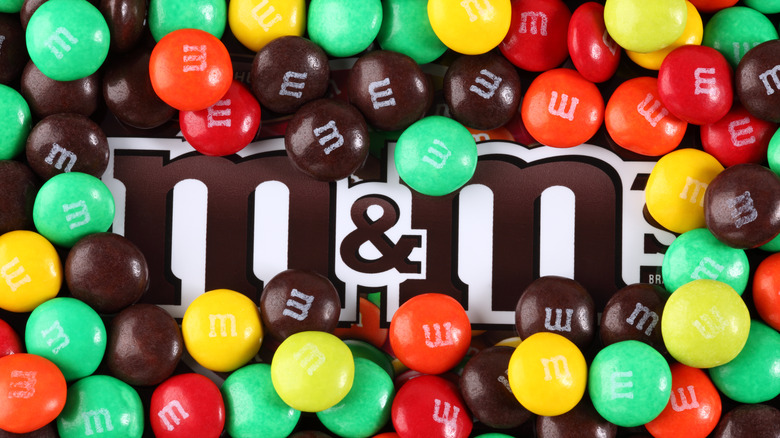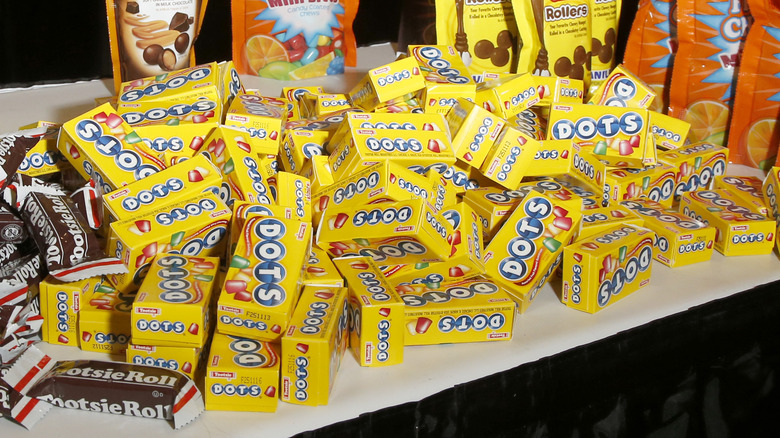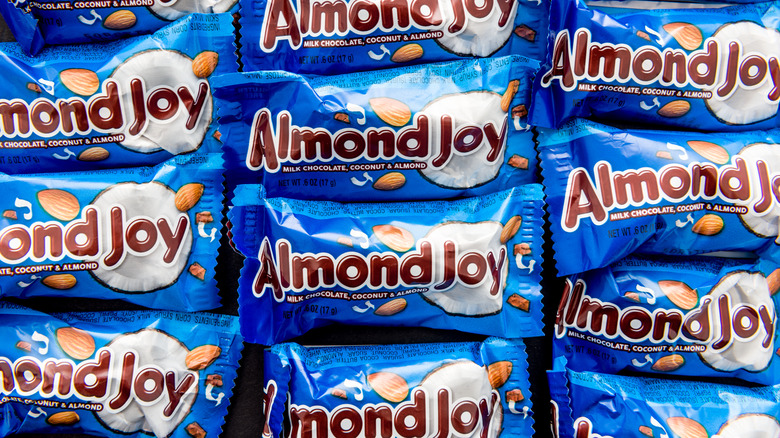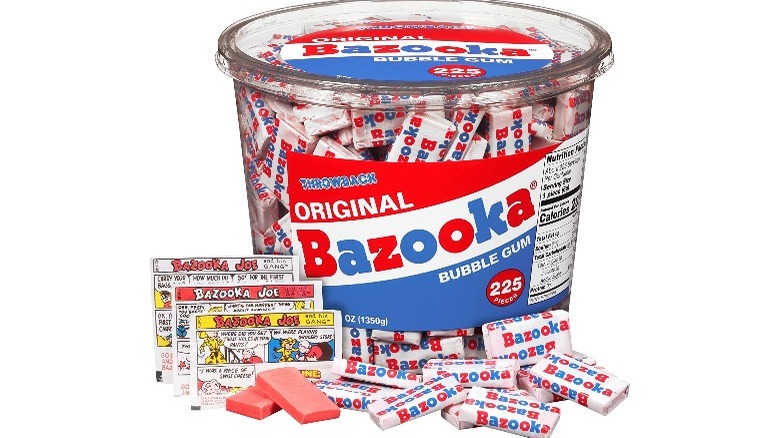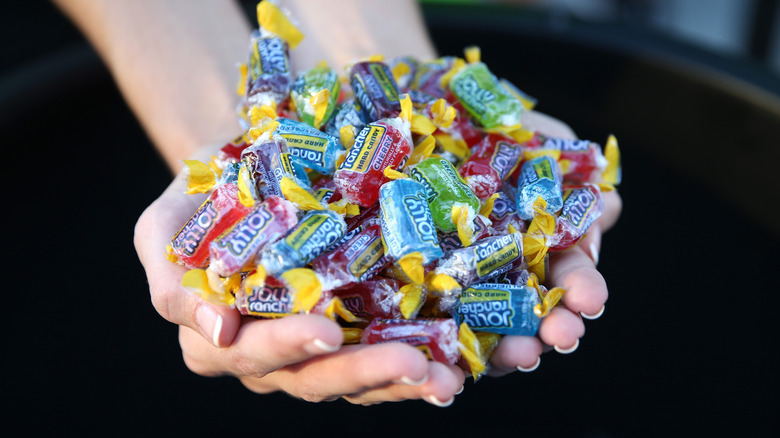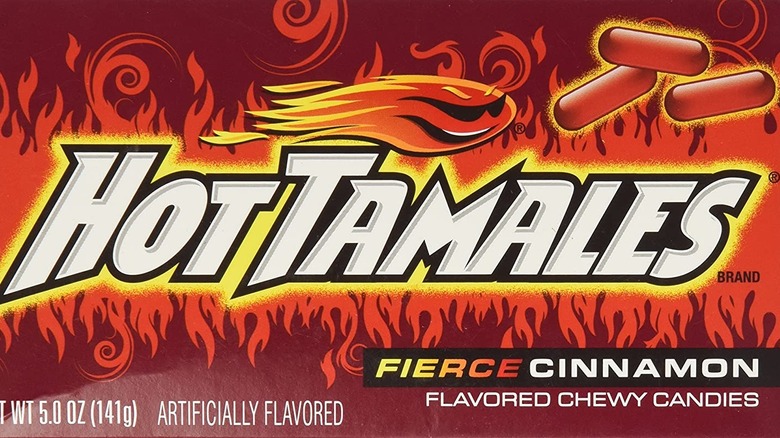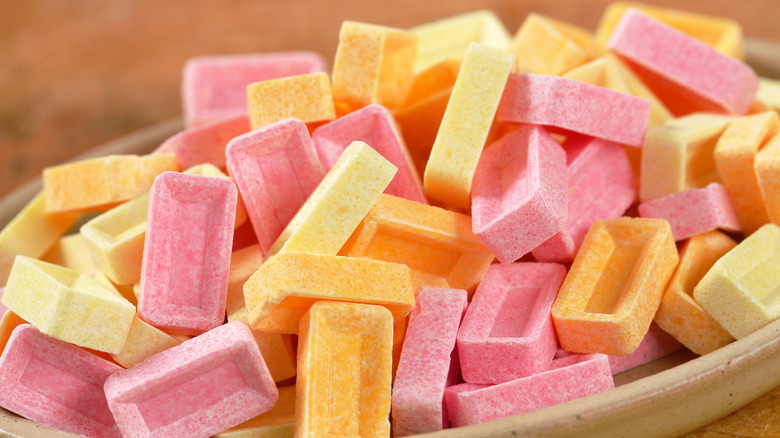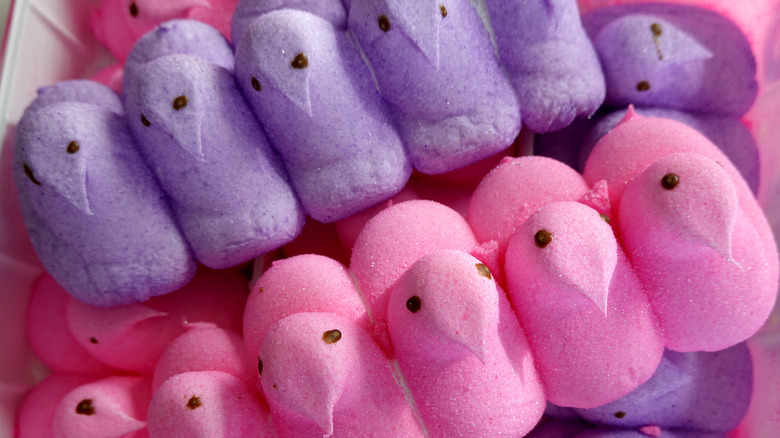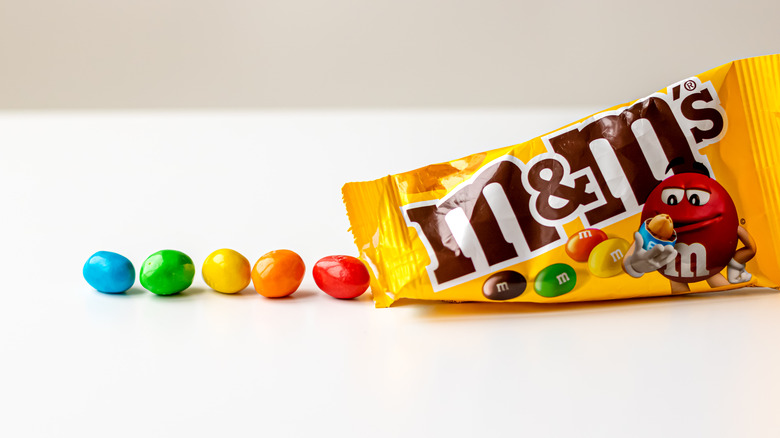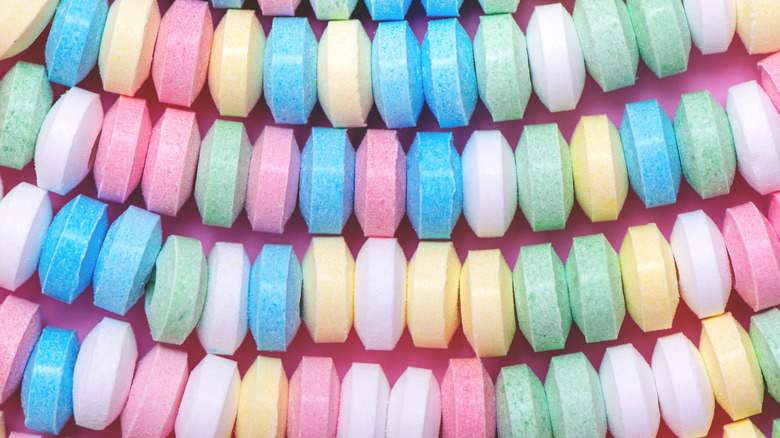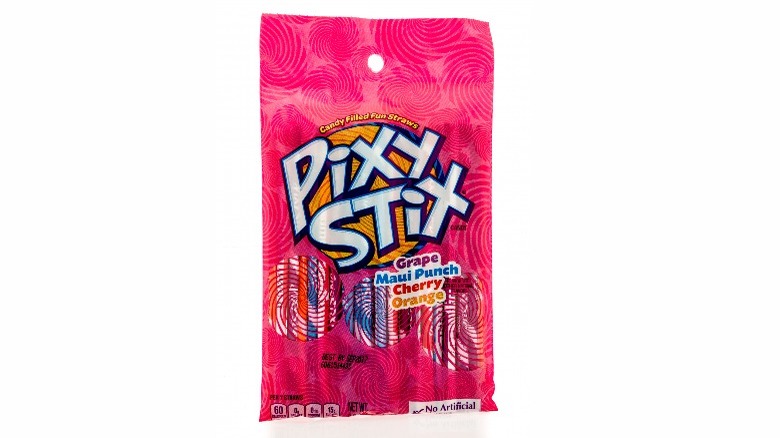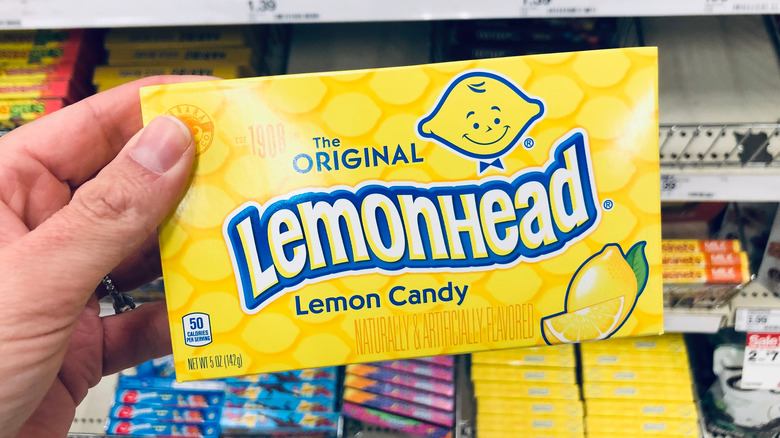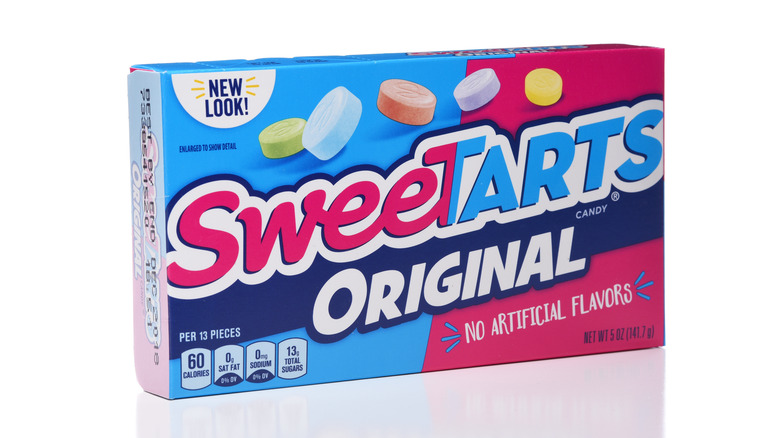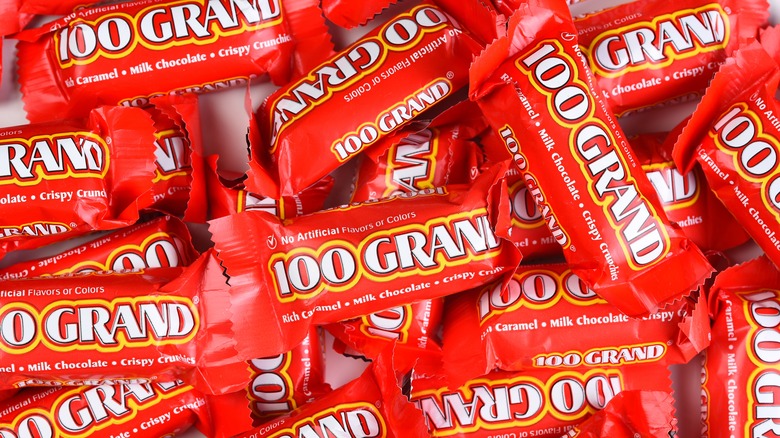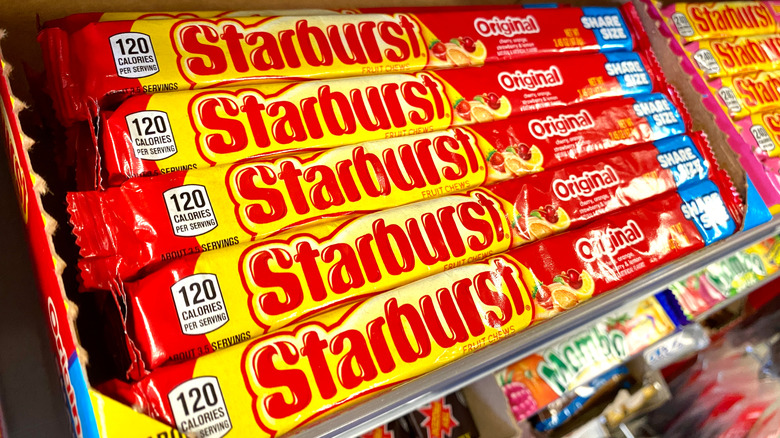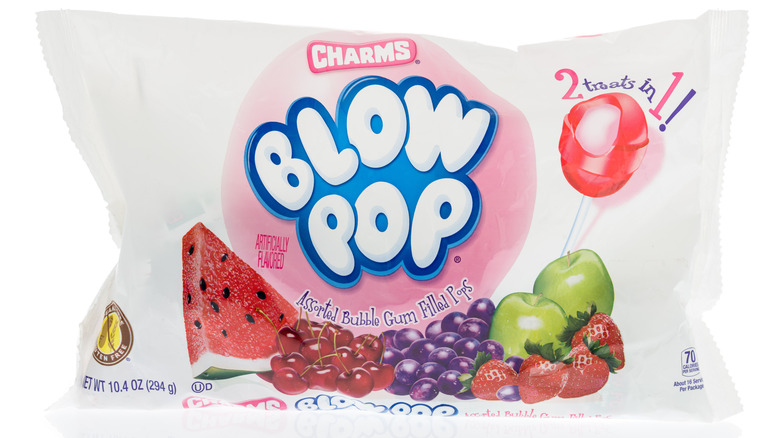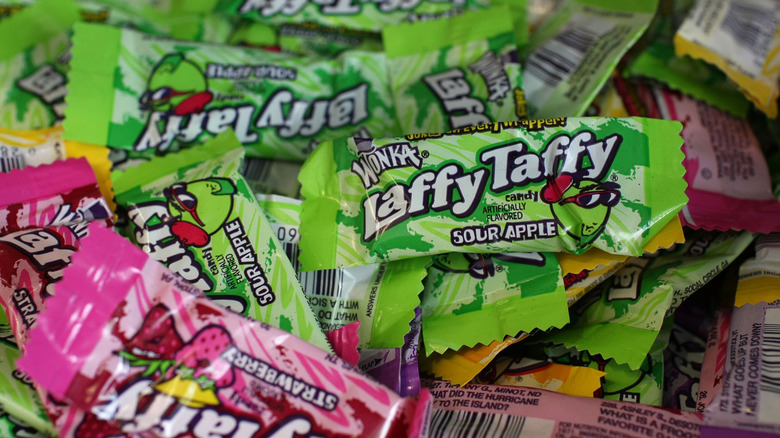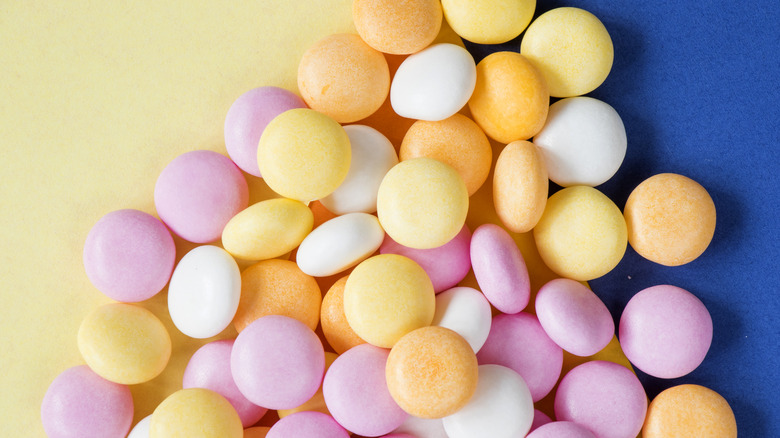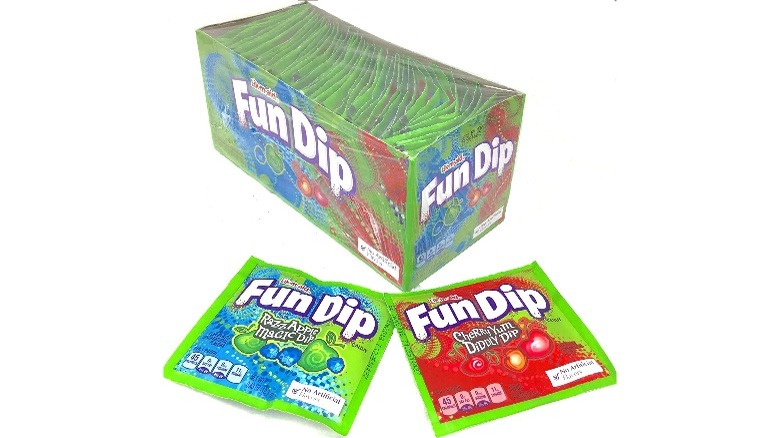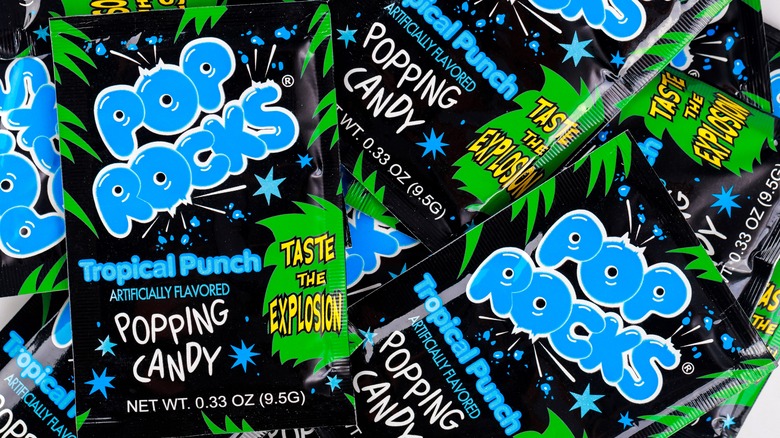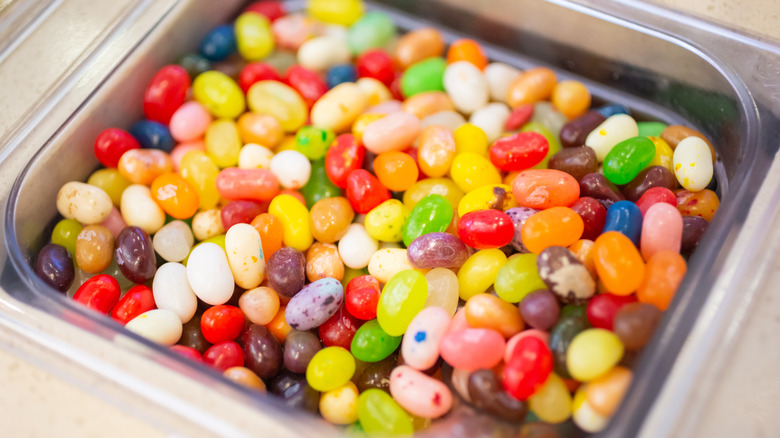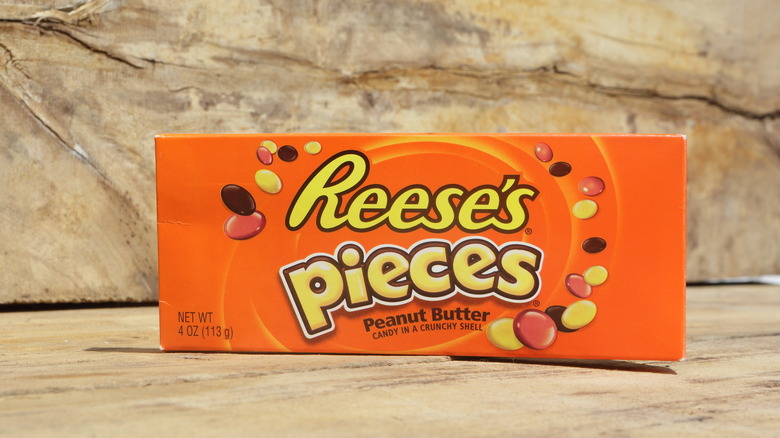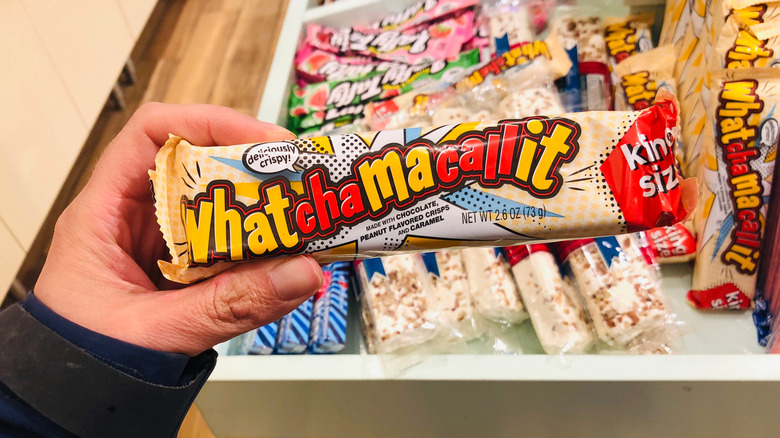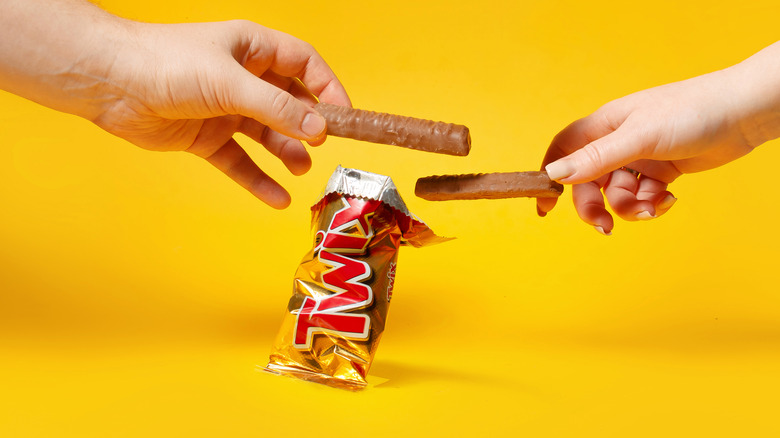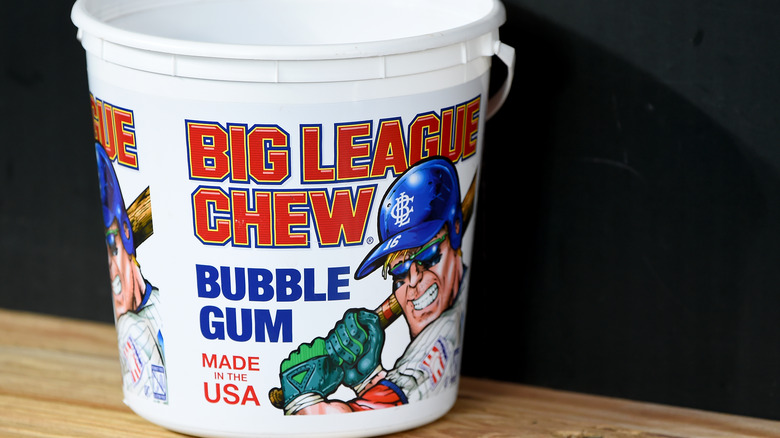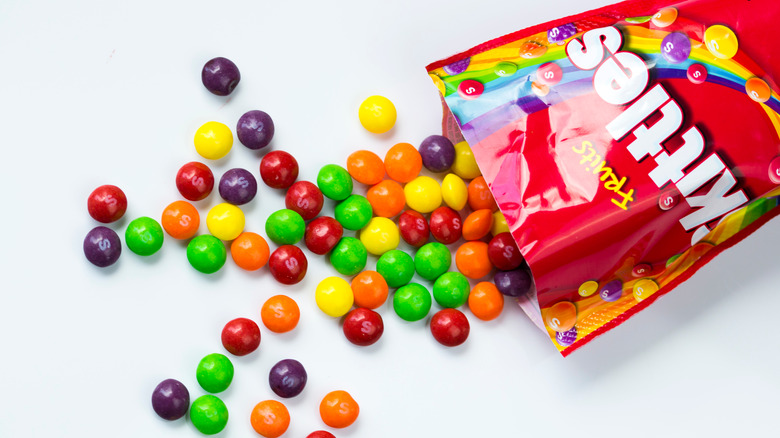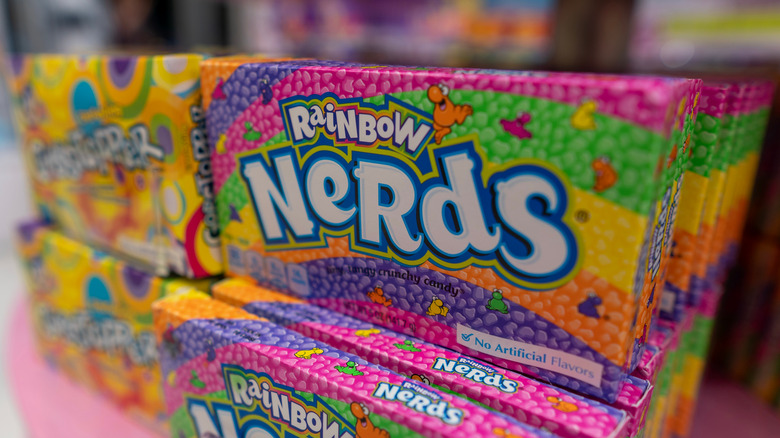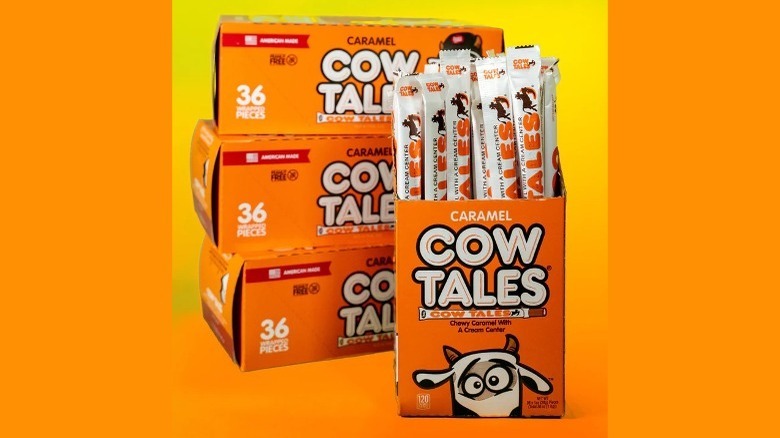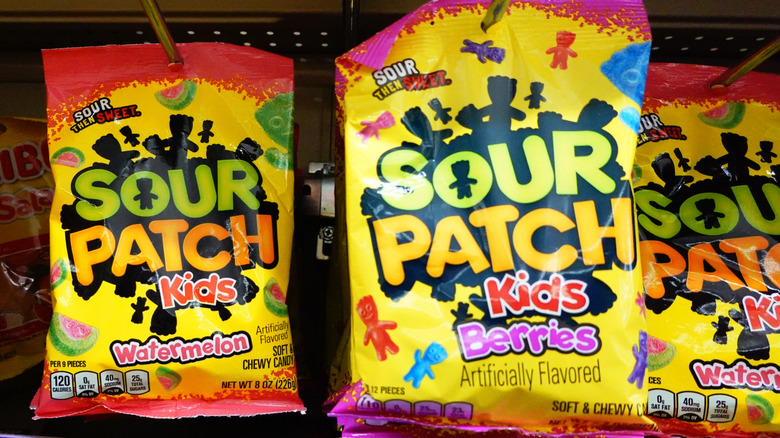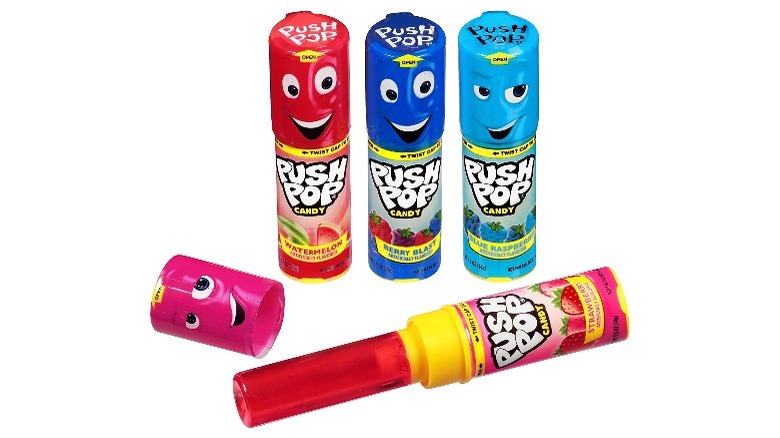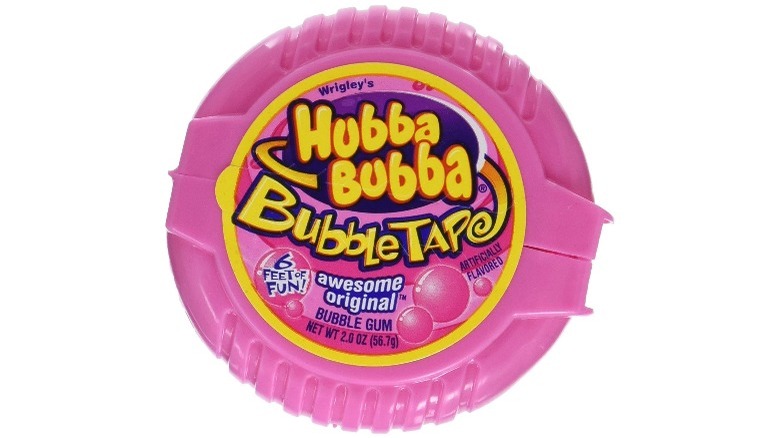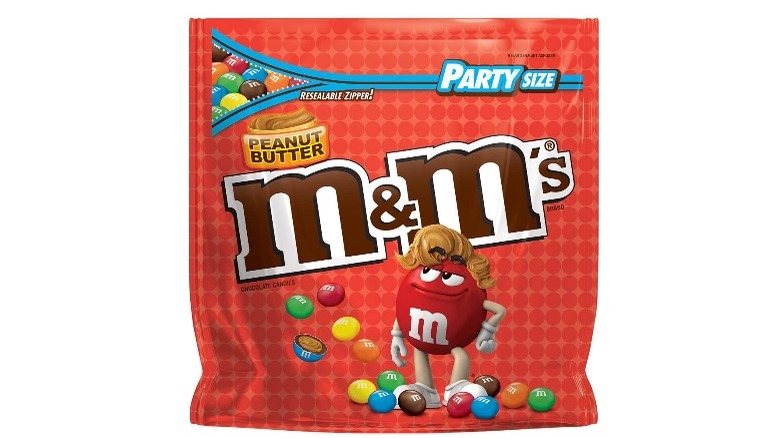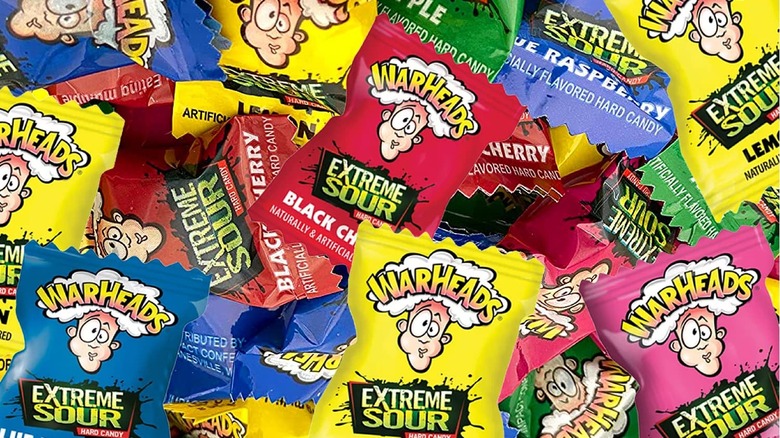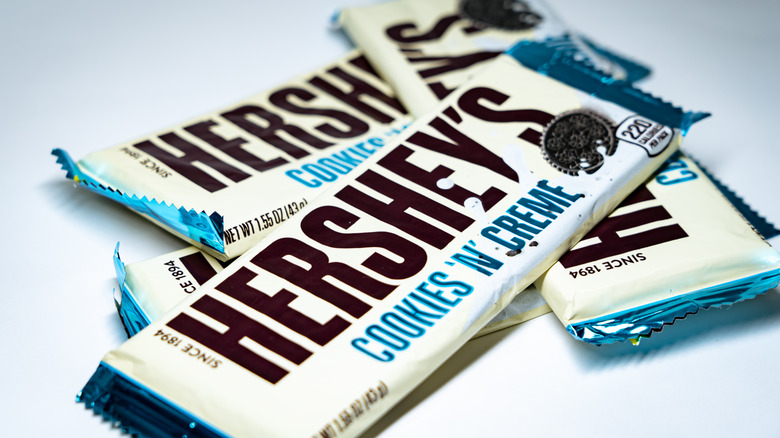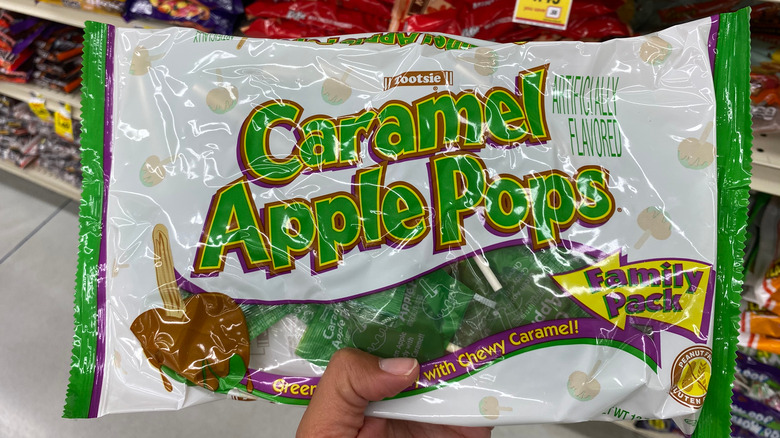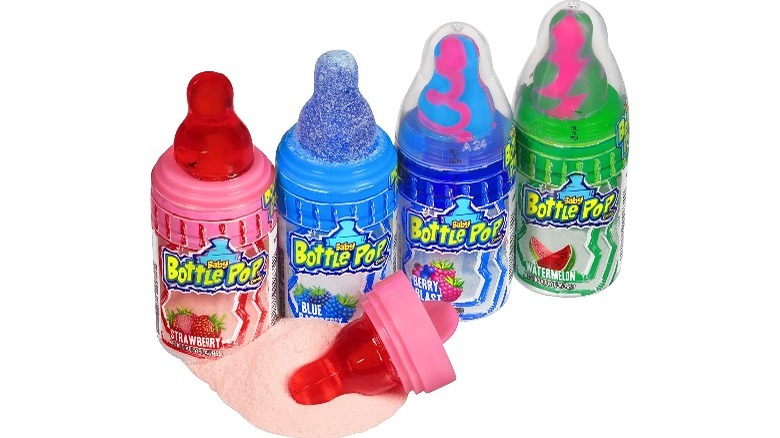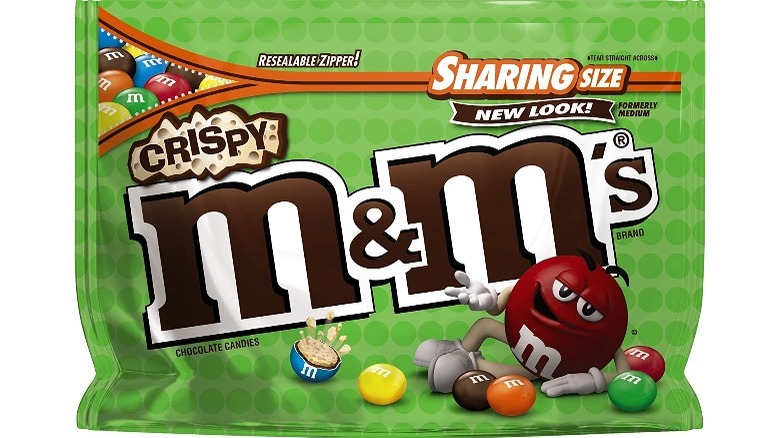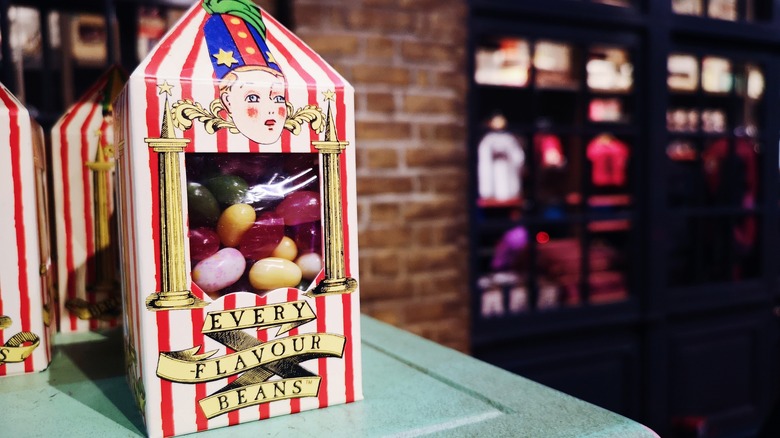The Most Popular Candy That Debuted The Year You Were Born
No childhood is complete without candy. From birthday parties to Halloween to Easter egg hunts, sugary sweets are the ultimate reward, indulgence, and small taste of happiness for every kid. But what children snacked on has changed throughout the years as new candies hit store shelves with each passing decade. The treat you loved most as a child very well could depend on the most popular candy that debuted the year you were born, so we tracked those sweets down.
Now, not every single year had a popular candy hit store shelves, but the vast majority of years between 1936 and 2000 had something sweet arrive on the scene. The 1930s and '40s, for instance, saw the arrival of classic chocolate confections kids today still know and love, such as Hershey's Miniatures, M&M's, and the Almond Joy.
As time went on, the candies got fruitier and kitschier. The '50s and '60s were playful with candy necklaces, Pixy Stix, Lemonheads, and Charms Blow Pops, while the 1970s, '80s, and '90s innovated with packaging, playfulness, and interactivity with candies like Pop Rocks, Bubble Tape, and the Baby Bottle Pop.
1936: Mallo Cup
A chocolate-covered marshmallow is a classic confection that would seem hard to innovate. Enter the Mallo Cup in 1936. Invented by brothers Bill and Bob Boyer, this cup candy first got its shape by being formed in cupcake papers.
1938: Krackel
Nestle's Crunch bar was such a massive success that rivals Hershey came up with a crisped rice chocolate bar of their own in 1938. The Krackel was first sold as a full-size chocolate bar, until being relegated to just a mix-in in Hershey's Miniatures in 1997. In 2014, the full-size Krackel hit store shelves once again, making fans of this classic candy very, very happy.
1939: Hershey's Miniatures
Even in the olden days, chocolate lovers couldn't pick just one candy bar. Thankfully, the Hershey Company rolled out its mixed assortment, Hershey's Miniatures, in 1939. This mixture has always contained the most popular Hershey's candy bars in "fun size" form. Today, this product is still going strong for indecisive sweets fans and trick-or-treat season; today, the mix includes milk chocolate bars, Special Dark chocolate bars, Krackel, and Mr. Goodbar.
1940: York Peppermint Pattie
The York Peppermint Pattie may be a favorite refreshing candy nationwide today, but when the York Cone Company launched this treat in 1940, it was only available in the northeastern United States. It didn't go national until 35 years after its initial debut, in 1975. And while the York Peppermint Pattie is the biggest candy to debut in 1940, it wasn't alone. The chewy fruit candies Mike and Ike also first hit store shelves at the beginning of this decade.
1941: M&M's
Before they became one of America's favorite candies with corporate icons that are nearly as beloved as Mickey Mouse, M&M's were just... the American version of a British candy. Yes, when these candy-coated chocolate buttons debuted in 1941, they were essentially a rip-off of Smarties, which Frank C. Mars had seen soldiers eating during the Spanish Civil War a few years earlier.
1945: Dots
It's hard to find a gumdrop that is more satisfying than Dots, which made their grand debut in 1945. These fruity candies come in cherry, lemon, lime, orange, and strawberry flavors. Though they're more famous today, Dots were actually preceded by another gumdrop candy from the same brand, Crows. As their name implies, Crows are all-black and are flavored like licorice.
1946: Almond Joy
If you felt like a nut in your coconut candy bar, you were out of luck until 1946, when the Almond Joy debuted in the American market. Though today it's very closely associated with the almond-less Mounds bar, they two confections did not come out in the same year. Mounds precedes the Almond Joy by 26 years.
1947: Bazooka Bubble Gum
Though Bazooka Bubble Gum was historically best known for its small comic strips, when this chewing gum was introduced in 1947, it was comic-less. Yes, Topps added in Bazooka Joe and his wacky adventures in 1953. Today, gum fans will have to look elsewhere for a laugh; Bazooka swapped out comics for brain teasers in 2012.
1949: Jolly Rancher
The year 1949 was a big one for new candies, and Jolly Rancher made its debut in November. While these hard candies come in cherry, blue raspberry, grape, green apple, and watermelon flavors today, when they came on the scene, they were only available in watermelon, grape, apple, and Fire Stix (cinnamon). Whoppers, Smarties, and Junior Mints also first hit store shelves at the end of the 1940s.
1950: Hot Tamales
The 1950s got off to a fiery start, thanks to the debut of Hot Tamales at the start of the decade. If you're not a fan of chewy cinnamon sweets with a candy coating, you also had an option to cool down in 1950. Andes Chocolate Mints, best known as an after-dinner treat, also came out this year.
1952: Pez
Pez, which stands for the German word for peppermint, PfeffErminZ, first appeared in the world in 1927 as a sweet peppermint candy. The Pez we know and love today wouldn't appear in the United States until 25 years later in 1952, when the Pez dispensers were given little cartoon heads and marketed as candy for children.
1953: Peeps
There are a lot of things you don't know about Peeps. For instance, did you know when they were acquired by Just Born in 1953 it would take over 27 hours to make one Peep? After JustBorn purchased the brand, the process was streamlined and the time to make these sugar-coated marshmallow birds was slashed, allowing them to be sold nationwide!
1954: Peanut M&M's
M&M's were first made in 1941, but it wasn't until 13 years later that the arguably more popular Peanut M&M's came on the scene. And while Peanut M&M's come in basically every color these days, when they first hit store shelves, they were only available in tan. Generally, 1954 was a good year for people who enjoy circular candy-coated treats; Atomic Fireballs also debuted this year.
1958: Candy Necklaces
The history of the candy necklace is a murky one, but this wearable confection reportedly was first released in 1958. Little girls and boys have been stylish despite their sticky necks ever since!
1959: Pixy Stix
The sour sugar-bomb that is the Pixy Stix may feel like a modern invention, but it's actually a relic of the 1950s. Yes, these sweet-filled paper straws first rolled out nationwide in 1959 in the signature color-striped packaging we know today. Before that, Pixy Stix were sold just as the powdered candy Lik-M-Aid in the 1940s.
1962: Lemonheads
Sweet, sour, hard, and chewy fruit candies seemed to be a theme in 1962. Not only is this when Now and Later hit shelves, Lemonheads also debuted this year. Though they initially only came in the citrus fruit flavor, today you can find Appleheads, Cherryheads, and Grapeheads.
1963: SweeTarts
Even though you may think all of your SweeTarts are the same flavor, they aren't! When these tiny, chalky candies debuted in 1963, they came in the same fruit flavors as their Pixy Stix counterparts: cherry, grape, lemon, lime, and orange. Today, lime has been replaced by green apple, and a blue SweeTart, blue punch, has been introduced to the packages.
1966: 100 Grand Bar
Though it's known as the 100 Grand Bar today, when this chocolate, crisp rice, and caramel confection debuted in 1966, it was called the $100,000 Bar. Po-tay-to, Po-tah-to!
1967: Starburst
Originally introduced in 1960 in the U.K. under the name Opal Fruits, Starburst underwent a name change and made their way stateside in 1967. Though the Original Fruits package today contains strawberry, lemon, orange, and cherry, those were not the original flavors. Initially, a package of Starburst contained strawberry, lemon, orange, and lime candies.
1969: Charms Blow Pops
For the longest time, you had to choose between eating a lollipop or chewing gum. The tragedy! Luckily, the Charms Blow Pop entered the scene in 1969 and quickly became the Charms Company's best-selling candy. Bubblegum fans were having a good time in '69; Fruit Stripe Gum also came out this year.
1971: Laffy Taffy
The 1970s got off to a bit of a funny start; Laffy Taffy debuted in 1971, which just so happened to be the same year "Willy Wonka & the Chocolate Factory" arrived in movie theaters. The name for this candy couldn't be more fitting. Not only does it have a taffy-like texture, but each candy comes with a few (often very punny) jokes submitted by children written on the wrapper.
1972: Mentos
While Mentos were released in the Netherlands in 1948, the United States couldn't be fresh and full of life until 1972, when these chewy mints came to the country. While they're known for their mint and fruit flavors today, when Mentos were first released in the Netherlands, they were licorice flavored.
1973: Fun Dip
Originally called Lik-M-Aid and essentially being Pixy Stix sold in packet form, Fun Dip as we know and love it today debuted in 1973. Lime, cherry, and grape were the original flavors of this genuinely fun candy, which comes with a sugar stick called a "Lik-a-Stix." Today, Fun Dip is most commonly found in cherry, grape, and "RazzApple" flavors.
1975: Pop Rocks
The 1970s were all about fun, interactive candies. If Fun Dip and Laffy Taffy weren't already a good enough time, Pop Rocks exploded onto store shelves in 1975. Though they're found everywhere today (including in Oreos), Pop Rocks weren't an immediate success. The concept was patented in 1961, but the candy wasn't released until '75 and wasn't widespread until the 1980s.
1976: Jelly Belly
Though jelly beans have been around since the 1800s, the iconic, relatively miniature jelly bean known as the Jelly Belly wasn't around until the American bicentennial in 1976. And though this candy is available in an almost infinite number of flavors today, when they debuted just eight flavors were available: root beer, green apple, licorice, cream soda, lemon, tangerine, Very Cherry, and grape. 1976 was a colorful year for candy; Gobstoppers also came out this year.
1977: Reese's Pieces
Though Reese's Pieces came out in 1977, they weren't wildly popular until 1982, when "E.T. the Extra-Terrestrial" hit movie theaters. The titular character in that film is crazy about Reese's Pieces and helped the then-struggling candy to become the hit it is today.
1978: Whatchamacallit
What do you call the ingredients in a Whatchamacallit? Today, it's peanut-flavored crisps, caramel and a thin chocolate coating. But upon its debut in 1978, this long-winded candy bar featured a peanut butter-flavored crisp and chocolate only.
1979: Twix
Twix have been available in the U.K. since 1967, but they didn't come stateside until 1979. The bar's British origin is reflected in this candy's name; Twix actually is short for "twin biscuit sticks," reflecting the candy's two-in-one packaging. Ring Pops and Hubba Bubba bubblegum also debuted in 1979.
1980: Big League Chew
It may not be the most politically correct candy today, but Big League Chew was a major league hit when it was released in 1980. Inspired by the tobacco-chewing habit of baseball players in the '70s, this bubblegum allowed children to emulate their favorite players without risking addiction to anything other than sugar.
1982: Skittles
First made internationally in the 1970s, Skittles were first produced and distributed widely in America in 1982. Like many popular candies, the green Skittles were originally lime flavored but were swapped for the trendier green apple in 2013. Fruit candies were all the rage in 1982; Runts debuted this year as well.
1983: Nerds
If you thought Nerds were pretty much just sugar coated in even more sugar, than you'd be right! Since 1983, Nestle has been making and selling these tiny balls of pure sweetness to massive success. And okay, they're not 100% sugar; there is some fruit flavoring on the outer shell. Most commonly, Nerds are strawberry and grape (better known as pink and purple).
1984: Goetze's Cow Tales
While it may seem like Goetze's Cow Tales have been around for centuries (and while they may sit in your trick-or-treat bag for years), this long, chewy caramel with a cream center has actually only been around for 35 years! Yes, Cow Tales first hit the market in 1984. However, the Goetze's Candy Company has been making its flagship product, Caramel Creams, since 1918.
1985: Sour Patch Kids
Originally called Mars Men, these tart little kid-shaped candies were renamed to Sour Patch Kids in 1985 to latch onto the cultural phenomenon that was the Cabbage Patch Kids. Generally speaking, 1985 was a big year for fruity candies with kitschy names; Airheads came out this year, too.
1986: Push Pop
Up until 1986 and the debut of the Push Pop, you really only had one way to eat a lollipop (on a stick). The unique packaging on this treat allowed you to eat some candy now and easily save some for later, solving a longtime conundrum.
1988: Bubble Tape
What's the measure of a candy's success? Apparently, it's how long it is! After its introduction in 1988, Bubble Tape, the super-sugary, super-sweet bubblegum was a huge hit with kids. This was due in large part to its unique packaging and promises of 6 feet of bubble fun.
1991: Peanut Butter M&M's
First came the M&M, then the world met Peanut M&M's, and then in 1991 a new kid arrived on the block... Peanut Butter M&M's. How are these candy-coated confections different than their rival Reese's Pieces? Peanut Butter M&M's have a small chocolate layer, whereas Reese's Pieces do not.
1993: Warheads
No candy quite defines the 1990s quite like the super sour Warheads, which came on the scene in 1993. And while this candy rose to massive popularity in the U.S. near the end of the 20th century, it was first invented in Taiwan in 1975.
1994: Hershey's Cookies 'n' Creme
The iconic Hershey bar got a funky new variation in 1994: Hershey's Cookies 'n' Creme. This white chocolate bar mimics cookies and creme ice cream with little crunchy chocolate cookie bites in each bar.
1995: Caramel Apple Pops
Every fall, those green apple-flavored lollipops with a chewy caramel coating hit store shelves. While it seems like the aptly named Caramel Apple Pops have been around forever, they're a relatively modern favorite Halloween candy; they debuted in 1995.
1998: Baby Bottle Pop
If you thought kitschy packaging was left in the 1980s, you would be wrong. The Baby Bottle Pop, a lollipop that came with a baby bottle tip lollipop and a sugary powder in the bottle, was released in 1998. The iconic jingle still plays on loop in many millennials' heads to this day.
1999: Crispy M&M's
A lot of M&M's flavors have come and gone through the years — RIP Dulce de Leche M&M's — but one flavor debuted, was pulled from shelves and returned again: the Crispy M&M. This chocolate with a crunchy wafer center first hit stores in 1999 before being discontinued just six years later. Luckily for fans of this candy, Crispy M&M's made a triumphant return in 2015.
2000: Bertie Bott's Every Flavor Beans
Though Jelly Belly jelly beans had been around for decades by the time the new millennium rolled around, the brand got a new life thanks to the cultural phenomenon known as Harry Potter. In 2000, Bertie Bott's Every Flavor Beans debuted, inspired by the hit fantasy series. Though these boxes of beans featured classic jelly bean flavors like blueberry and cinnamon, they also include more — shall we say — unique flavors, such as earthworm, booger, sausage, and vomit. And if you think this food trend is weird, earwax-flavored jelly beans are nothing compared to the most peculiar food trend from the year you were born.
